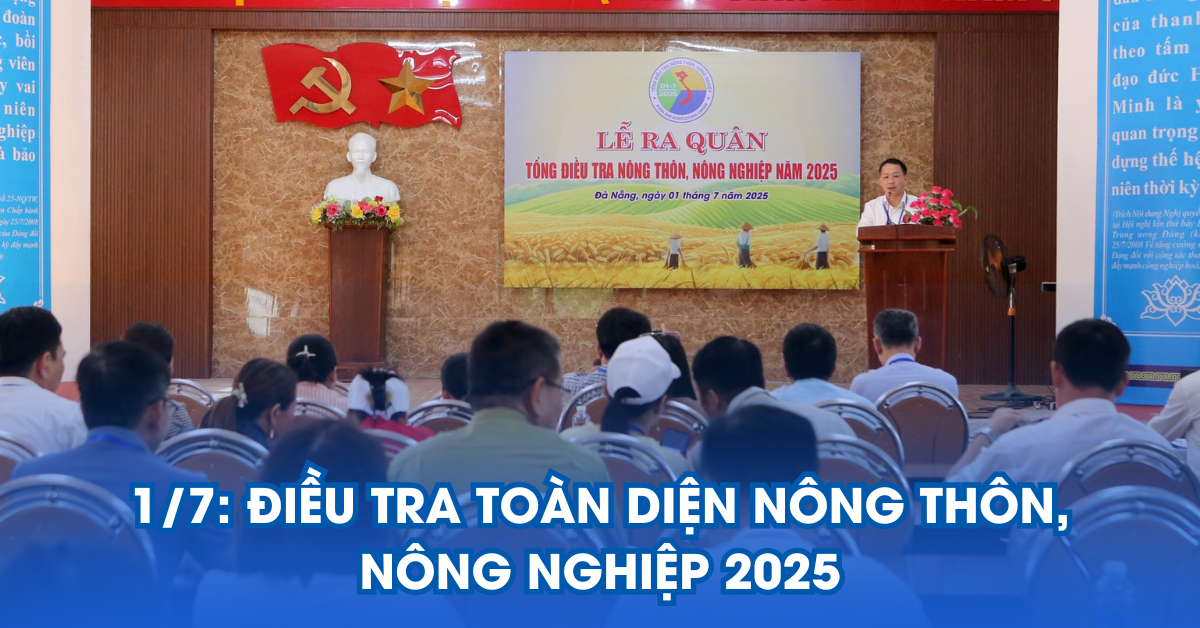JULY 1: COMPREHENSIVE RURAL AND AGRICULTURAL CENSUS 2025
04 Aug 2025

On July 1, 2025, the Comprehensive Rural and Agricultural Census 2025 will officially be launched simultaneously across the country. This decennial survey, organized by the General Statistics Office, aims to collect extensive agricultural survey data to inform policy making and guide sustainable rural development in the new period.
Overview of the largest survey in a decade
The Comprehensive Rural and Agricultural Census 2025 is among the three largest statistical surveys in Vietnam. This initiative is designed to review and document the current state of rural development and the agriculture, forestry, and fishery sectors, while providing accurate data to support national target programs.
The collected information will cover all agricultural production households, farms, cooperatives, agricultural enterprises, and rural residential areas.
Objectives and scope
The census focuses on three main objectives:
- Assessing current conditions and analyzing trends in agriculture, forestry, fisheries, and rural livelihoods.
- Establishing a comprehensive agricultural survey database for research, policy planning, and as a foundation for annual sample surveys.
- Supporting the monitoring and evaluation of the Government’s rural and agricultural development programs.
Innovations and data collection technology
The 2025 census introduces significant improvements over the previous round. Key highlights include:
Implementation of electronic survey forms
For the first time, electronic survey forms will be applied nationwide in two formats:
- CAPI (Computer-Assisted Personal Interviewing): Enumerators use tablets to conduct interviews and enter data directly.
Webform: Respondents fill out information via online forms themselves.
The introduction of electronic forms reduces manual recording time, increases data accuracy, and shortens processing timelines.
Integration of digital mapping technology
In this census, digital mapping supports:
- Precisely identifying data collection locations.
Managing the scope assigned to each enumerator. - Preventing duplication of surveyed subjects.
Digital maps are a new tool that help control progress and improve operational efficiency at the local level.
Application of machine learning for data validation
Machine learning technology will be used to:
- Analyze agricultural survey data.
- Detect logical errors or missing information.
- Automatically suggest corrections before final report compilation.
As a result, the output data quality will be transparent and consistent nationwide.
Linking household and farm data
Another important innovation is the ability to link data between household surveys and farm surveys. This synchronization will:
- Accurately reflect production scale and rural labor.
- Support the creation of detailed reports for specialized research.
- Serve as a basis for evaluating production effectiveness and household living standards.
Online management of progress and quality
The entire process will be managed through an online data management system, enabling:
- Real-time monitoring of data collection progress.
Transparent assignment of enumerator responsibilities. - Data quality checks from the commune level to central authorities.
This system also helps shorten processing time after data collection ends.
Vehicles mobilized to encourage citizens to participate in the 2025 Rural and Agricultural Census. Source: Internet
Cost savings and improved accountability
Thanks to the unified adoption of digital technology, this year’s census is expected to:
- Reduce organizational costs compared to traditional methods.
- Improve accountability among enumerators and statistical agencies.
- Build public trust with citizens and surveyed groups.
Timeline and progress
According to the plan, the census will proceed through key phases:
- March–May 2025: The General Statistics Office collaborates with local authorities to create household listings, allocate areas, and prepare personnel.
- July 1, 2025: Official nationwide data collection begins.
- End of July 2025: Completion of data recording and processing of results.
These milestones serve as the foundation for local units to proactively implement and ensure data quality.
Significance for sustainable rural development
The results of the Comprehensive Rural and Agricultural Census 2025 will contribute to building a complete picture of agricultural production, rural living conditions, and shifts in labor structure.
Accurate statistical data will enable management agencies to design effective development policies, improve farmers’ incomes, promote sustainable rural development, and meet the demands of international integration and agricultural digital transformation.
Farmers harvesting the season’s crop, all data to be recorded. Source: Internet
Conclusion
July 1, 2025 marks an important milestone, launching the Comprehensive Rural and Agricultural Census 2025 – the most extensive survey in the past decade. The close coordination of Agricultural Households, Management Units, and the entire team of Enumerators will determine the success of this nationwide data collection effort. The results of the Census will provide a reliable data foundation to support Policy-Making, promote Sustainable Rural Development, and improve the Quality of Life for people across Vietnam in the new period.
Views
467
